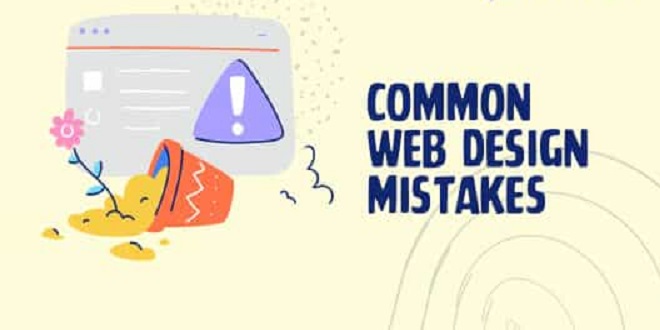These are the Top 5 CSS Mistakes Web Designers Make and How to Avoid Them

Cascading Style Sheets are a crucial component of a website’s structure. You can incorporate a sense style and design into an HTML layout. It can handle everything, from font colors and font families to alignment and presentation.
It is also unquestionably the easiest programming language to learn. It is simple to modify an element’s attributes using a list of properties that are almost entirely written in English.
Take a CSS tutorial to learn all about CSS.
CSS can be complex, even though it appears simple, especially when used on a large scale. CSS can be confusing because of the many ways elements can be selected and the multitude of attributes that can apply to them. This makes it easy to get lost when using CSS on multiple devices and browsers.
These are the most common errors web developers make. Learn how to identify and avoid them so you can design more efficient and productive CSS!
CSS: How can CSS help you work more efficiently?
Cascading style sheets simplify web page interaction. It allows us to create a web page that provides a user-friendly experience and allows the user to navigate quickly. It also portrays the page in a way HTML alone cannot. It is also slightly heavier than HTML, but it can be used to adjust the size of the web page.
It simplifies the work of users and simplifies the implementation for web developers. Depending on how many CSS codes you have to add, you can choose between internal or external CSS styles. Each type of styling is a simple way to add style to a website.
Advantages
It gives the web page a sense of civility. It enhances the interaction platform of the web page, which allows users to feel more comfortable when using the online application. CSS can be used for many purposes. We will look at the common benefits of CSS, which make it an integral part of web design, and more specifically user interface development.
Makes it easier to use Sometimes, a website created using HTML can seem difficult to manage. This enhances the page’s beauty and makes it look elegant and simple, allowing the user focus on their task.
Enhance the page’s appearance: Use the Cascading Stylesheet language to improve the page’s appearance. There are many characteristics of CSS that can be used to design a web page.
Modify the web page layout: This feature interacts with the structure of the page and transforms it in the way that the developer wishes. This allows web designers to customize the interface of the application to the target domain.
Easy to integrate: This offers many benefits and it is easy to integrate CSS with HTML. There are many ways to incorporate CSS into a website, and you can use any one of them quite quickly.
Simple programming: CSS is not a programming language, but a style language. CSS writing is easy because there are only a few characteristics you need to remember.
Top CSS Mistakes
Color names are preferred to Hexadecimal
You are simply telling the computer to display the color blue by specifying the color: blue. You are giving the browser control over how your web pages should look. This is something that you shouldn’t do as a developer. It can be difficult to distinguish the color you intended from the one it is. Worse, it can also change between browsers.
All developers should use hexadecimal values such as colour: #4169E1. This standard ensures precision, is compatible across all browsers and allows you to control how your web pages are displayed.
Invalid declarations Fallbacks
You’re lucky enough to have access some of the less-supported CSS3 properties. Chrome Canary’s most powerful machine is a great platform for building, but some users might need fallbacks. It is a very common mistake to completely forget about fallbacks.
Is there a fallback for rgba()? Hopefully you have one; otherwise your IE8 users won’t see it. Are you sure that all vendor prefixes have been covered? Are you able to eliminate some prefixes later on? Preprocessors are useful because you can write once and then use it anywhere.
Coders also make far too many incorrect declarations.
CSS Lint is a great tool to help you resolve this issue. However, a general knowledge of CSS Lint may be helpful. You can remove any item that appears incorrect in the developer tools.
Make a mess out of your units
It’s time for you to act if your CSS contains a mixture of px and em. Style sheets are often the first thing that people notice about font sizes. To replace all font-size pixels units, use ems. Em-based units of measurement are able to control readability and pixel density, making them one of the most important constants in consumer electronics.
Ethan Marcotte’s classic book Responsive web design, which explains why ems are important, is a great primer.
If you don’t like ems or their nested properties, rems, also known as root em units, can be used to keep the element relative to the root element (often, the html> element). It is important to maintain a consistent course of action, even though there is much debate about the components of the web.
Using IDs instead of Classes
One of the strongest arguments against IDs is their specificity. This makes it hard to modify or expand your styles. An ID’s style cannot be replaced by a class. You would need to either create additional IDs, or use the existing IDs in order to “beat” it. Important, as it could lead to specificity disputes within your stylesheets.
Unlike IDs which are unique for each element, class selectors can be used to create multiple HTML components on the same webpage. One of the benefits of CSS is the ability to reuse styles.
You can create consistent styles and IDs by using only class properties. Then, integrate interactivity with Javascript to maintain consistency.
Disorganized CSS
Instead of creating styles as you see them, arrange your code. You will be able to navigate your file the next time that you edit it.
Comment your CSS It’s a good idea to add a block comment between the logical parts of your stylesheet. This will help you locate various areas quickly during a scan, or give you something to search for so you can jump directly to the CSS. It doesn’t matter if you annotate every line, most of the CSS will be self-explanatory. You should only comment on the instances where you made a particular choice for a reason.
Add Logical Sections to Your Stylesheet: It’s a good idea that you start your stylesheet using all the standard styling. This includes any additional styling that you may add to the element. You will usually have rules for the body, p and h1, h2, links, and h3, respectively. You may then create utility classes or attributes which include information that you know will be useful for a variety different elements. You can then add CSS to specific items. This can be done by separating them by context, page, and even component.
Conclusion
Expect a rise in websites due to the exponential growth of internet users. As demand rises, so will the opportunity for growth and development in CSS applications. Over the next few years, web designers will be in high demand.
Web designers at any company can also become very proficient in this technology, and often work as freelancers. Freelancer.com and Upwork.com are two examples of online portals that connect freelancers to those who want them.
You can also do web design remotely. This means you have the possibility to get contracts from overseas. We hope you found this list useful in helping you avoid similar errors in the future.





